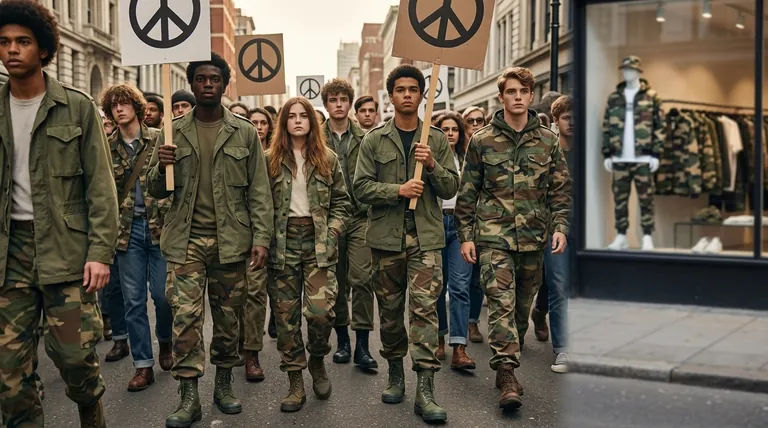Historically, camouflage fabric entered the world of fashion in the 1960s. Its journey from military uniform to style staple began when anti-war activists adopted it as a symbol of protest, transforming its meaning and catching the eye of the wider cultural landscape.
Camouflage's entry into fashion was not a planned design trend but a political act of subversion. By wearing the uniform of the military to protest a war, activists forever severed the pattern from its purely functional roots and turned it into a powerful cultural symbol.

The Path from Protest to Pop Culture
The adoption of camouflage was a slow burn that moved from the streets to subcultures before finally hitting the mainstream runway. It represents a classic example of how fashion often absorbs and reinterprets potent social symbols.
A Symbol of Dissent
During the Vietnam War era of the 1960s, anti-war protesters began wearing military surplus, including camouflage jackets and pants. This was a deliberate, ironic statement.
By taking the clothing of the soldier and wearing it in a context of peace and protest, they stripped the pattern of its intended authority and re-appropriated it as a symbol of their opposition.
The Rise in Subcultures
Following its use in protests, camouflage was adopted by various subcultures throughout the 1970s and 1980s. Punk, and later hip-hop, embraced the pattern for its rugged, anti-establishment connotations.
This period was crucial for cementing camouflage as a symbol of rebellion and street-level authenticity, moving it beyond a single political movement.
The Leap to High Fashion
The final step was its adoption by high-fashion designers. Seeing its enduring appeal and rich cultural history, designers began incorporating camouflage into their collections.
This move legitimized the pattern within the formal fashion industry, transforming it from a niche statement into a versatile print available to a mass audience.
Navigating Its Complex Meaning
The primary challenge and appeal of camouflage lie in its layered and often contradictory symbolism. Its meaning is not fixed; it changes dramatically based on who is wearing it and in what context.
The Original Intent: Concealment and Authority
In its original military context, camouflage is about blending in to avoid detection. It is a tool of the state, representing order, conflict, and authority.
The Subversive Act: Rebellion and Visibility
In fashion and protest, camouflage is used to stand out. Wearing it in a civilian context is an act of separating the pattern from its original meaning, turning a symbol of conformity into one of individuality and rebellion.
The Modern Interpretation: Pure Aesthetics
Today, for many, camouflage is simply a pattern, disconnected from military or political associations. It is often treated like leopard print or plaid—a visually interesting design used for purely aesthetic reasons. This can sometimes create tension with its more loaded historical meanings.
Interpreting Camouflage in Your Wardrobe
How you use camouflage depends entirely on the statement you wish to make, whether it's a conscious one or not. Understanding its context is key to using it effectively.
- If your primary focus is street-style credibility: Camouflage connects to a long history of anti-establishment subcultures and urban authenticity.
- If your primary focus is a bold fashion statement: Luxury brands use camouflage to play with high-low culture, blending a rugged pattern with refined silhouettes.
- If your primary focus is simply aesthetics: The pattern can be used as a neutral, adding visual texture and an edge to an everyday outfit without any deeper meaning intended.
Ultimately, the journey of camouflage from the battlefield to the runway shows that the meaning of any symbol is never truly fixed.
Summary Table:
| Era | Key Milestone | Cultural Significance |
|---|---|---|
| 1960s | Anti-War Protests | Symbol of political dissent and subversion. |
| 1970s-80s | Punk & Hip-Hop Subcultures | Embraced for its rugged, anti-establishment edge. |
| Late 20th Century | High-Fashion Adoption | Legitimized as a versatile, mainstream print. |
Ready to incorporate iconic styles into your product line?
As a large-scale manufacturer, 3515 produces a comprehensive range of footwear for distributors, brand owners, and bulk clients. Our production capabilities encompass all types of shoes and boots, allowing you to leverage timeless trends like camouflage with quality and scale.
Contact us today to discuss your manufacturing needs and bring your vision to life.
Visual Guide

Related Products
- Factory-Direct Wholesale Canvas Boots with High-Traction Rubber Soles
- Durable High-Ankle Tactical Boots for Wholesale & Custom Manufacturing
- Durable Canvas Work Shoes with Rubber Lug Sole | Wholesale Manufacturer
People Also Ask
- What role do slip-resistant rubber materials play in safety shoes? Ensuring Grip and Stability in Hazardous Workplaces
- Why are rubber soles beneficial in cold-weather boots? Superior Traction & Waterproofing
- What should be avoided when storing boots with outsoles? Protect Your Investment from Dry Rot & Decay
- Why is rubber a popular material for shoe soles? Unbeatable Grip, Durability & Value
- What types of work environments are hiker-style rubber outsoles best for? Ideal for Outdoor & Industrial Safety


